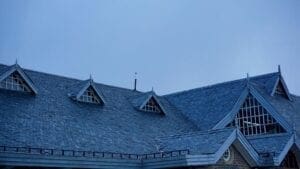5 Things That Can Damage Your Roof’s Underlayment
 Your roof is composed of several layers: the decking, the underlayment, and the roofing shingles themselves. But even if your roofing shingles look okay, your roof could experience damage to one of the lower layers. Here are five things that can damage your roof’s underlayment.
Your roof is composed of several layers: the decking, the underlayment, and the roofing shingles themselves. But even if your roofing shingles look okay, your roof could experience damage to one of the lower layers. Here are five things that can damage your roof’s underlayment.
1. Inexpert Installation
There are several ways that incorrect installation can damage the integrity of the underlayment so that it will fail early or cause problems with the roof. For example, if the underlayment isn’t fastened correctly, it could shift when walked on. Or if the contractors don’t walk carefully, they could damage and tear the underlayment so it doesn’t protect as well.
Your roofing contractor can also cause problems with the underlayment by installing the roof shingles while the underlayment is still wet. This can cause water to be trapped under the roofing shingles, and when the roof heats up, the underlayment and the roof may begin to wrinkle.
2. Water
If water wicks up from under the edges of the roofing shingles, it can reach the underlayment itself and cause swelling and deterioration. The typical type of underlayment used for asphalt shingle roofing is called tarpaper because it’s made of paper products with tar embedded. Modern underlayments may sometimes have fiberglass in them as well.
As you can imagine, water seeping into a substance that’s primarily made of paper can be a big problem. This can cause the tarpaper to expand, again causing wrinkling or deformities, which causes seeping through the paper until it no longer provides protection from the elements.
3. High Temperatures
You may have heard stories about shingles that were damaged because the roof was in full sun without adequate ventilation. And while roofing materials typically are designed to withstand high temperatures, it’s also true that extra-high temperatures can damage asphalt materials.
While the roof itself may suffer from cracking or bubbling, the underlayment may also suffer damage, especially if it experiences high temperatures during the installation process, as the tar will soften and the product may then become more easily damaged when walked on. However, high temperatures after installation can cause early failure as well.
4. UV Rays
UV rays are a type of radiation that can damage many surfaces and materials, even asphalt roofs and underlayment. Fortunately, the underlayment won’t come in contact with many UV rays most of the time. But if it’s used to protect a roof for long periods of time before the shingles are put on, it can suffer deterioration.
Another time the UV rays may come into contact with the underlayment is when a shingle is missing, cracked, or lifted out of place, which exposes the tarpaper to the sun. The UV damage can eventually make the tarpaper fall apart so the elements can get right through to the roof deck. This is why it’s so important to get roof repairs taken care of right away.
5. Pests
Pests such as raccoons can actually rip right through shingles, tarpaper, and roof deck to make their way into your attic. They’ll often attack at vulnerable spots such as the join around a roof vent. Smaller pests are more likely to squeeze in at the eaves or enter through vents.
To avoid raccoon damage, make sure all trees are trimmed back well away from your roof and put collars on downspouts to avoid giving them easy access. Then check your yard to make sure you don’t have any food sources that could make raccoons want to live in or around your home. And finally, keep your roof wellmaintained so they don’t find soft spots to dig through.
These are five things that can potentially damage the tar paper under your shingles. Guard against them to make sure this vital component of your roof can perform its job for years to come. If you suspect your underlayment may be damaged or that you need any other type of roofing repair or maintenance, get in touch with R. L. Hayes today.
R L Hayes Roofing & Repairs
3540 Wheeler Rd Ste 103
Augusta, GA 30909
(706) 869-1193
https://rlhayes.com/
